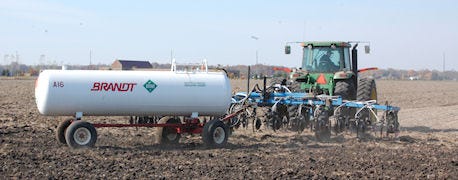
Meth is a problem is rural communities and on farms. Why? Because one of the most popular "recipes" calls for anhydrous ammonia as a key ingredient.
Methamphetamine or "meth," is a highly addictive nerve stimulant similar to caffeine or even cocaine. It is frequently manufactured in rural remote areas with quick and easy access to farms that use anhydrous as a fertilizer.
A new Purdue Extension publication gives community leaders insight into the meth scourge so they can work to solve the problems it causes in Indiana, which leads the nation in meth lab raids.

Anhydrous ammonia: A key ingredient in the 'recipe' for meth. Are your rural community leaders aware of the problem and working towards a solution?
"While nationwide methamphetamine use has followed a decreasing trend in recent years, meth use in Indiana has shown an increasing pattern," write authors Janet Ayres, a Purdue University agricultural economist, and graduate research assistant Danielle Carriere.
There were 1,797 meth lab seizures in Indiana in 2013, the highest number of any state in the nation, according to the researchers. The number of meth lab seizures in Indiana began to rise starting in 2007 after a couple of years of decline and since has surpassed its peak in 2004.
The authors of Methamphetamine Use in Rural Indiana explain the effects of meth use, describe trends in the illegal drug's use in rural areas and suggest possible ways local leaders can combat the problem.
The publication is the latest in a series, begun in 2013, to help state and local leaders better tackle the many quality-of-life issues facing people in the most rural counties in Indiana, such as those involving business development, unemployment, education, availability of health care and healthy food and access to broadband Internet services.
The authors say the effects of meth use and production go beyond the obvious health problems, which include an increase in admissions to substance abuse treatment facilities for meth addictions from 2003 to 2013.
Buildings where meth is produced must be decontaminated before they are considered safe to occupy, and the cost is so high that it is sometimes cheaper to demolish a building.
The authors say people in rural communities should become more aware of seriousness of this problem and get involved to help solve it.
Each publication in the rural Indiana series is available free for download at Purdue Extension's The Education Store.
About the Author(s)
You May Also Like




